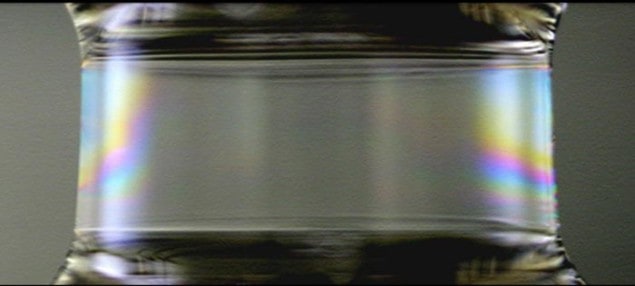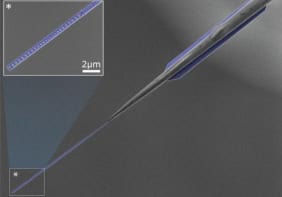
A team of researchers in France has found that applying a voltage across a 100-nm-thick cylindrical soap film causes the fluid inside it to flow upwards. If the voltage is increased, the film thickens and the flow rate increases significantly. The researchers say this could be useful in microfluidic systems and to stabilize liquid foams.
The field of microfluidics involves the manipulation of minute amounts of liquids – generally picolitre (10–12) quantities – within micron-width channels. This allows scientists to work with substances that are expensive to produce in large quantities. Also, it allows many different liquids to be used simultaneously, creating a “lab on a chip” platform for the study of many chemical processes at once.
Soft channels
Anne-Laure Biance, Oriane Bonhomme and colleagues at the University of Lyon in France have been studying nanochannels in their lab, and became interested in producing soft nanochannels, as compared with hard ones, because they felt that such soft channels would be easier to make and use, and would cost less. So the researchers looked at soap films – a soft deformable channel that consists of two sheets of ionic surfactant molecules that enclose a layer of water. Biance also feels that soap films are convenient as their thickness is usually at the nanometre scale and they are easy to make.
The team used two platinum-covered plates (the electrodes), separated by about 0.5 cm, facing each other. The researchers then created a bubble out of a soapy liquid made of water, a surfactant and potassium chloride that produces the free ions, and trapped this bubble between the plates.
“We then applied different voltages to the plates, and observed that the liquid inside the bubble flows from the bottom to the top,” explains Biance. The walls of the bubble act as the channel for the flow. As the surfactant molecules are positively charged and the chloride ions are negatively charged, the molecules attract and this causes the drag. That is, the surface ions are pulled by the electric field and they drag the fluid inside the channel along with them.
Drag and flow
This behaviour, known as an “electro-osmotic” flow, can be described as the motion of liquid induced by an applied potential across a porous material, capillary tube, membrane, microchannel or any other fluid conduit. The effect of this type of flow becomes more pronounced at the micro- and nanoscale, where there is a high surface-to-volume ratio. While this has been studied with solid nanochannels, Biance says that not enough is known about the behaviour in soft channels, where the ratio can change.
When Biance and her colleagues measured the magnitude of the flow in their experiment, they also found that the soap film itself had thickened. The researchers could distinguish between the current caused by surface ions and the current caused by the flow of the liquid being dragged (bulk flow). They found that as they increased the voltage, the bulk flow increased at a faster rate than expected. “This was because our film was actually thickening. We could see a change of colour of the film too, and this is only seen when there is a thickness modification,” explains Biance. “We measured the growth of the film’s upper meniscus, where it touches the plate, and we measured the growth rate,” she says, which proved that a wider channel allows the rate of flow to increase quickly.
Thickening effects
Biance told physicsworld.com that this thickening effect is comparable to another effect that explains why a solid plate lifted out of a liquid bath is never dry. Instead, it lifts up a film of fluid thanks to viscous forces that come into play because the plate is being pulled and is known as the Landau–Levich flow. She also points out that the flow and the applied voltage have a nonlinear relationship. “This is interesting because it almost has diode-like properties,” says Biance. The team is also interested in seeing whether any of these effects would help in stabilizing liquid foams that collapse because of the effects of gravity on the liquid. “We might be able to use a voltage to stabilize them,” says Biance.
Currently, Biance and her colleagues are looking at how their experiment would change if they used two bubbles, placed side by side or on top of each other. “Other factors come into play, such as the border between the bubbles and the flow there. In the end, we would like to do this with many bubbles,” says Biance.
The research is published in Physical Review Letters.



